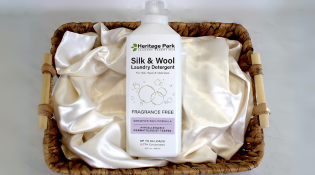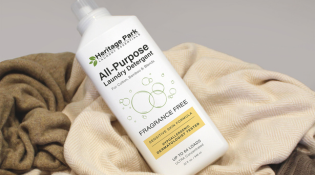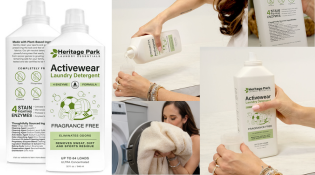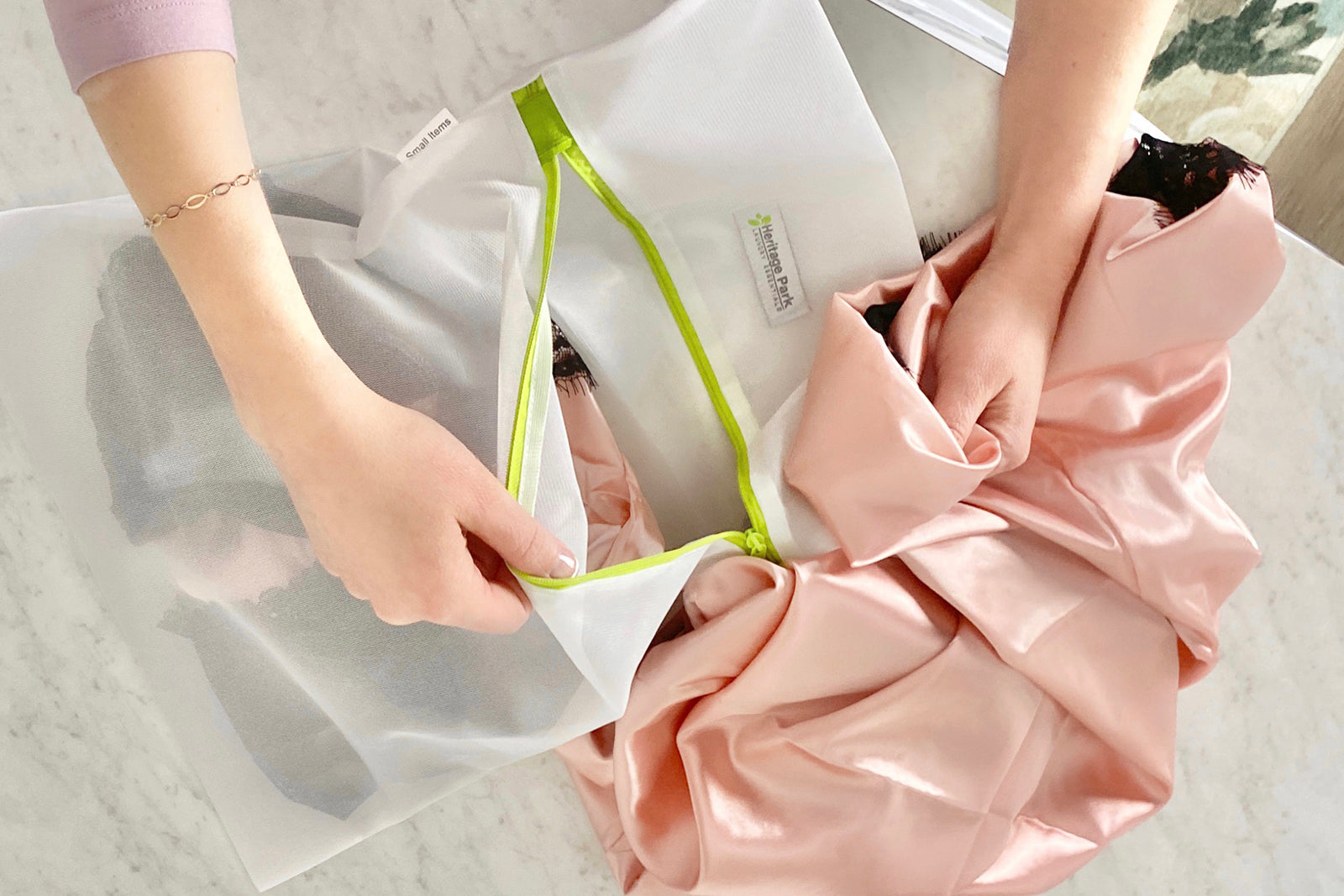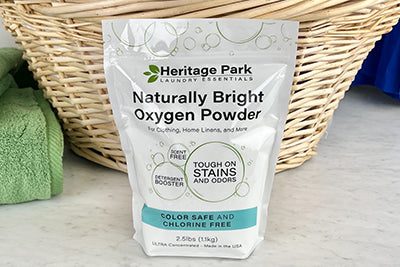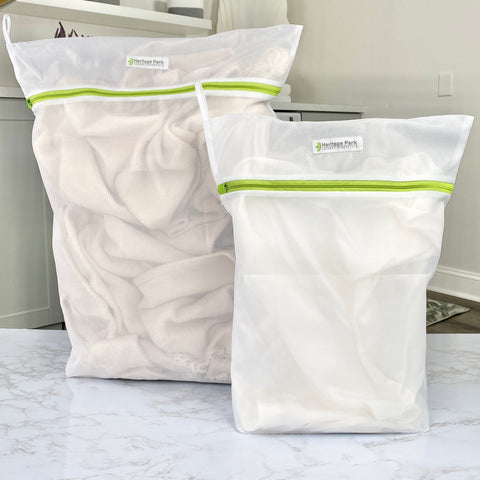Delicate fabrics add a touch of elegance and sophistication to our wardrobes, but caring for these items requires special attention to ensure they retain their beauty and longevity. This article offers tips for washing delicate items without causing damage.
Inside this Article:
- Delicate Laundry Deserves a Delicate Wash
- Why Are Some Fabrics Considered “Delicate?”
- The Most Common Delicate Materials and Apparel Items
- Tips for Washing Delicates with Success
- Read and Follow Care Labels
- Choose the Right Detergent
- Sort Delicates Properly
- Use A Mesh Laundry Bag
- Select a Delicate Cycle or Gentle Cycle
- Avoid Bleach and Fabric Softener
- Never Wring Out Delicates
- Hang or Lay Flat to Dry
- Other Options for Cleaning Delicates
- What About Delicate Bedding and Table Linen?
Delicate Laundry Deserves a Delicate Wash
Whether it’s luxurious lingerie, stylish silk blouses, or high-performance swim and athletic gear, delicate clothes are well-loved wardrobe pieces. But caring for delicate fabric can be a bit of a conundrum, even for those of us who spend a lot of our days doing laundry. On top of that, these pieces are not inexpensive, so we want to clean them while protecting them from damage. Heritage Park is here with the answers you need to clean and care for your delicate fabrics and help these favorites stay looking and feeling fabulous.
Why Are Some Fabrics Considered “Delicate?”
Luxury, specialty, and performance fabrics are often delicate due to their unique construction and composition, which provide specific functionalities and features. Here are a few reasons why these fabrics tend to be delicate.
- Fine Fibers: Specialty and performance fabrics are often made from fine fibers, such as microfiber, spandex, or modal. These fibers are lightweight and a bit more fragile.
- High-Tech Finishes: Performance fabrics often undergo specialized treatments to enhance their properties, such as moisture-wicking, stain resistance, or UV protection. These finishes can make the fabric more susceptible to damage if not handled with care.
- Stretch and Elasticity: Many performance fabrics, especially those used in activewear, are designed to stretch and conform to the body's movements. While this feature provides comfort and flexibility, it makes the fabric more prone to snags, tears, and distortion if pulled or stretched excessively.
- Complex Weaves and Knits: Specialty fabrics, including wool and cashmere, may feature intricate knits or weaves that create unique textures or patterns. These complex structures can be delicate.
- Chemical Treatments: Some fabrics undergo chemical treatments to achieve specific properties, such as water repellency or flame resistance. These treatments can alter the fabric's structure and make it more sensitive to harsh washing methods or abrasive agents.
- Sensitive Dyeing Techniques: Some fabrics are dyed using advanced techniques to create vibrant colors or patterns. These dyes might be sensitive to high temperatures or harsh chemicals, requiring careful washing to prevent fading or bleeding.
- Luxury and aesthetics. Here we’re talking about things like silk, satin, or anything with ornamentation like lace, buttons, or embellishment.
- Construction. Bras, swimsuits, and other garments with underwire or support must be treated as delicates to preserve the functionality of the structure.
The Most Common Delicate Materials and Apparel Items
Delicate fabrics encompass a wide range of materials, each requiring specific care to maintain their quality. Silk, lace, chiffon, and satin are common delicate fabrics known for their luxurious texture and sheen. Performance fabrics designed for activewear, such as moisture-wicking materials and spandex blends, also fall into the delicate category due to their specialized properties. Delicate clothing items include lingerie, bras, and nightgowns made from nylon, silk, or blends; swimwear and activewear, which are made for performance; hosiery that is prone to snags and tears; and anything with embellishment or wires.
Washable wool and cashmere are also considered a part of the delicate garment category; for the purposes of this blog, we will not be addressing how to wash wool. You can find detailed information on how to wash wool and how to choose the best wool detergent here.

Tips for Washing Delicates with Success
Follow these step-by-step guidelines to wash your delicates in the machine without risking damage:
Read and Follow Care Labels
Always check the care labels on your delicate items. Manufacturers provide specific instructions for washing, drying, and ironing to ensure the longevity of the garment. Consider the care label your blueprint to keeping your delicate item in the very best condition possible. Check out our guidelines to interpreting care symbols here.
Choose the Right Detergent
Select a gentle, pH-neutral detergent made to effectively clean and care for delicate fabric like Heritage Park All-Purpose Laundry Detergent. Our plant-based formula cleans with natural ingredients and a proprietary enzyme blend made to get out dirt and stains while protecting fabric (note: for silk and wool delicates, use our enzyme-free formula, Heritage Park Silk and Wool Laundry Detergent).
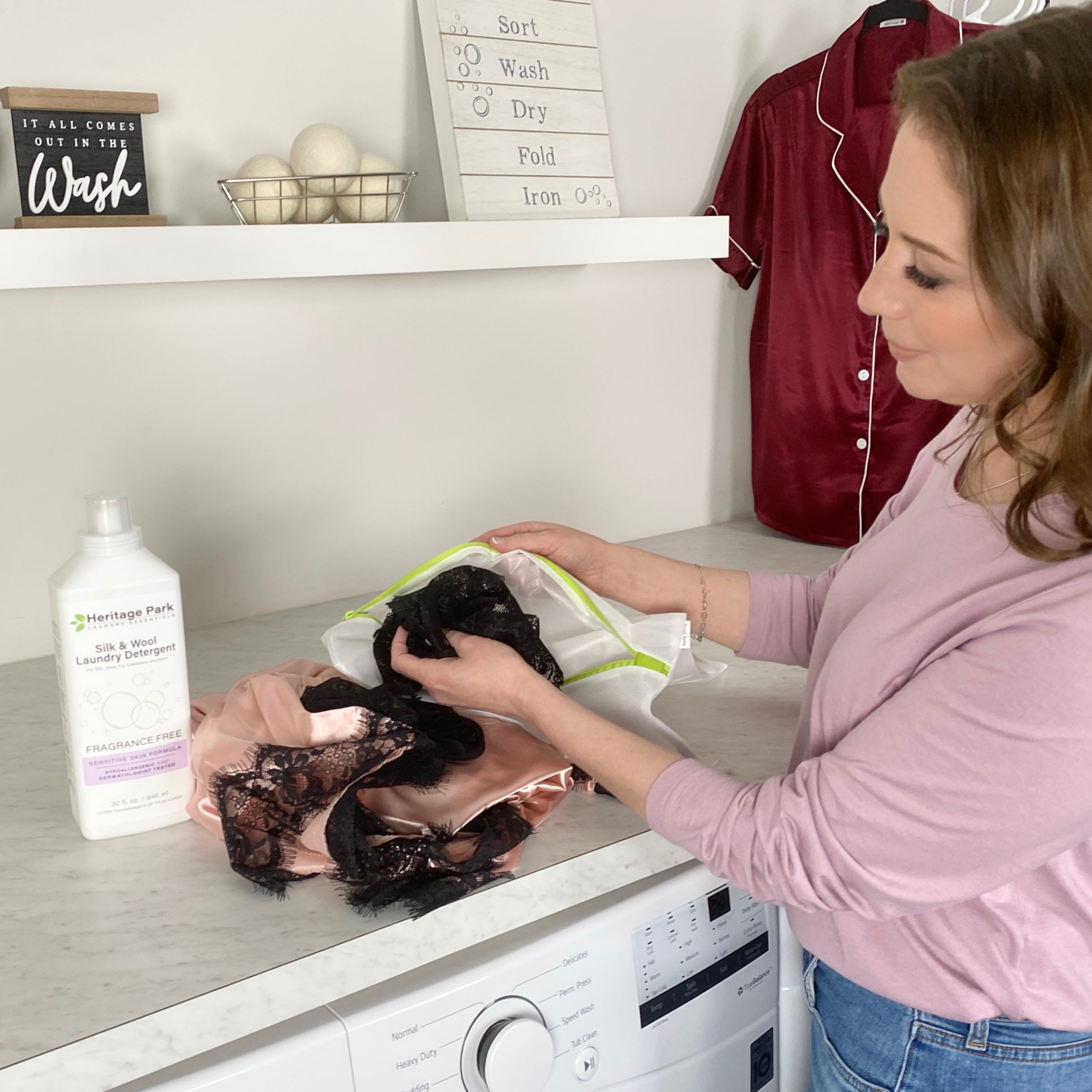
Sort Delicates Properly
Separate delicates into small loads based on weight, color, and fabric type. Washing similar items together prevents friction and potential damage during the wash cycle.
Use A Mesh Laundry Bag
Place delicate items inside mesh laundry bags before tossing them into the washing machine. These bags provide an extra layer of protection, preventing snags and tears.

Select a Delicate Cycle or Gentle Cycle
Most modern washing machines offer a gentle, handwash, or delicate setting designed for fragile fabrics. Use these settings to minimize agitation and reduce the risk of damage. Here’s a helpful guide to washing machine settings and cycles. When machine washing on a delicate cycle, it’s ideal to use cool or cold water, which won’t shrink fabric.
Avoid Bleach and Fabric Softener
Bleach can weaken delicate fibers, leading to fraying and discoloration. Similarly, fabric softeners can leave residues that affect the fabric's texture. Skip both products when washing delicates.
Never Wring Out Delicates
Squeeze out excess water gently or roll in a clean towel to avoid distorting the garment’s shape or wire structure.
Hang or Lay Flat to Dry
After washing, hang delicates to air dry. Avoid direct sunlight, as it can fade colors. Invest in a drying rack or use padded hangers to maintain the garment's shape while drying.
Other Options for Cleaning Delicates
If your delicates are incredibly fragile and you choose not to machine wash, consider these alternative cleaning methods:
- Hand Washing: To hand wash, fill a basin or clean sink with lukewarm to cool water and add a small amount of delicate detergent. Gently agitate the water and immerse the delicate item, allowing it to soak for a few minutes. Gently rub the fabric to remove dirt and stains. Rinse soapy water out thoroughly and follow the drying instructions mentioned above.
- Spot Treating Stains: For localized stains, use a mild stain remover or a mixture of water and mild soap. Apply the solution directly to the stained area and gently blot with a clean, white cloth. Avoid rubbing, as it can spread the stain. Rinse the fabric thoroughly after spot treating.
- Dry cleaning. Again, read the care label and consult with your local dry cleaner who may be better prepared to clean delicate materials and fabrics without damaging them.
What About Delicate Bedding and Table Linen?
When it comes to delicate bedding and table linen, the care guidelines often overlap with those for delicate clothing items. For a more in-depth discussion on how to care for delicate bedding and table linens, check out this blog on washing fine sheets and bedding here; silk bedding requires a bit of special care, which you can read about here.
You'll find that many of the guidelines discussed in the previous sections apply here as well, including the importance of reading care labels, using gentle detergents, sorting items by fabric and color, and opting for delicate cycles. However, some delicate bedding and table linen can be ironed to achieve a crisp, polished look. This requires keeping your iron clean and in good shape; you can learn more here.
By following these expert tips, you can ensure your delicate garments remain beautiful and in pristine condition for years to come. With the right care and attention, your delicates can continue to be a well-loved -- and well-used -- part of your wardrobe! Of course, if you have any questions about how to care for delicate items or how to pick a delicate laundry detergent, contact Heritage Park by phone or email. We are here to help!


